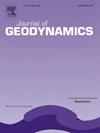Strain partitioning across the outer boundary of the Alboran Domain crystalline thrust sheet. Implications on the kinematic pattern of the Western Gibraltar Arc
IF 2.1
3区 地球科学
Q2 GEOCHEMISTRY & GEOPHYSICS
引用次数: 0
Abstract
Within orogenic belts, large thrust sheets commonly present a crystalline nature. Their thickness represents a significant portion of the total crust section and they are displaced along several tens of km or more. Due to their size and particular rheological properties, strain decoupling is expected to occur between these crystalline thrust sheets and the footwall units. In this work we characterize the structure of the Alboran crystalline thrust sheet (ATS), which forms the inner core of the Western Gibraltar Arc, a Neogene collisional arc that close the Mediterranean alpine belt to the west. In this setting, we explore the modes of strain partitioning occurring during thrusting both within the ATS and across the mountain front through the underlying units. This allows us to evaluate, within the geodynamic frame of the Western Mediterranean, the contribution of the ATS kinematics in the shaping of the entire Western Gibraltar Arc. Our results point out that the main structure of the ATS in its western part is a large-scale frontal culmination wall developed over a 25 km wide hanging wall ramp. Above this ramp, the rock column (nowadays up to 11–12 km thick) is affected by ca. N-S accommodation folds, mostly vergent to the west, which are likely produced by thrust-parallel simple shear. The inferred tectonic transport direction (nearly E-W) is parallel to those of the neighbouring fold-and-thrust belt units in the western front of the ATS but significantly differs from those in the northern boundary (>20º), suggesting a transpressive regime developed in the lateral parts of the thrust sheet. Moreover, strong evidence of fold-axis parallel extension is recorded within the ATS and in the underlying units. This likely indicates the deformation within the ATS was pure shear dominated and strongly partitioned, producing a large-scale thrust at its base (localized simple shear) coupled with vertical flattening and arc-parallel stretching evenly distributed within the hanging wall. We interpret this generalized extension along the orogenic grain, identified from the fold-and-thrust belt to the inner orogenic core, as kinematically linked to the outward fanning pattern of the tectonic transport directions around the Western Gibraltar Arc and in agreement with the progressive nature of the orogenic curvature. Our results highlight that the kinematics of the Western Gibraltar Arc is largely independent of the Europa-Africa convergence, and agree well with the proposed models of westward retreat –and associated slab tearing- followed by collision in the westernmost Mediterranean.
在Alboran域晶体逆冲片的外边界上的应变分配。对西直布罗陀弧运动格局的影响
在造山带内,大型逆冲片通常呈现结晶性质。它们的厚度占地壳总剖面的很大一部分,它们沿着几十公里或更多的方向位移。由于它们的尺寸和特殊的流变特性,预计在这些晶体推力片和下盘单元之间会发生应变解耦。在这项工作中,我们描述了Alboran结晶逆冲片(ATS)的结构,它形成了西直布罗陀弧的内核,这是一个新近纪的碰撞弧,靠近地中海的西部高山带。在这种情况下,我们探索了在ATS内部和通过底层单元穿过山前的逆冲过程中发生的应变分配模式。这使我们能够在西地中海的地球动力学框架内评价ATS运动学对整个西直布罗陀弧线形成的贡献。研究结果表明,ATS西段的主要构造是在25 km宽的上盘斜坡上发育的大型锋面高潮壁面。在此斜坡之上,岩柱(现今厚达11-12 km)受约N-S的调节褶皱影响,大部分向西倾斜,可能是逆冲平行的简单剪切作用。推断的构造输运方向(近东西向)与ATS西前缘邻近的褶皱冲断带单元平行,但与北部边界(>20º)的构造输运方向明显不同,表明逆冲片的侧向发育逆压机制。此外,在ATS和底层单元中记录了折叠轴平行扩展的有力证据。这可能表明ATS内部的变形以纯剪切为主,分区强烈,在其底部产生大规模的逆冲(局部简单剪切),并在上盘内均匀分布垂直压平和弧平行拉伸。我们将这种从褶皱冲断带到内造山心的沿造山带的广义伸展解释为与西直布罗陀弧周围构造运输方向的向外扇形模式有运动学联系,并与造山带曲率的递进性质相一致。我们的研究结果强调,西直布罗陀弧的运动学在很大程度上独立于欧罗巴-非洲辐合,并且与所提出的向西撤退-以及相关的板块撕裂-随后在地中海最西端发生碰撞的模型非常吻合。
本文章由计算机程序翻译,如有差异,请以英文原文为准。
求助全文
约1分钟内获得全文
求助全文
来源期刊

Journal of Geodynamics
地学-地球化学与地球物理
CiteScore
4.60
自引率
0.00%
发文量
21
审稿时长
6-12 weeks
期刊介绍:
The Journal of Geodynamics is an international and interdisciplinary forum for the publication of results and discussions of solid earth research in geodetic, geophysical, geological and geochemical geodynamics, with special emphasis on the large scale processes involved.
 求助内容:
求助内容: 应助结果提醒方式:
应助结果提醒方式:


